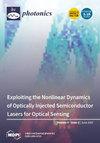用于特异性检测痕量 Pb2+ 离子浓度的高灵敏度光纤 MZI 传感器
IF 2.1
4区 物理与天体物理
Q2 OPTICS
引用次数: 0
摘要
本研究提出了一种新型壳聚糖(CS)功能化子弹头形中空光纤传感器,用于检测水环境中 Pb2+ 离子的痕量浓度。该传感器是一种光纤马赫-泽恩德干涉仪(MZI),由依次拼接的子弹型中空芯纤维(HCF)、细芯纤维和另一片拼接的子弹型中空芯纤维组成。通过调整放电量使中空芯纤维塌陷,形成具有不对称端面的锥形中空腔。子弹状空腔可作为光纤传感器的扩束器和耦合器,而光纤传感器则对称地拼接在一段细芯光纤的两端。模拟和实验结果表明,与平面和球形空腔相比,子弹状空心锥形空腔能激发更多的包层模式,对外部环境的变化更加敏感。以 Pb2+ 离子为模板制备了离子压印壳聚糖(IIP-CS)薄膜,并在其表面均匀涂布,以实现对 Pb2+ 的特异性识别。同时,该传感器在离子检测过程中表现出优异的选择性、重复性和稳定性,在未来重金属离子检测方向上具有巨大潜力。本文章由计算机程序翻译,如有差异,请以英文原文为准。
Highly Sensitive Optical Fiber MZI Sensor for Specific Detection of Trace Pb2+ Ion Concentration
A novel chitosan (CS) functionalized optical fiber sensor with a bullet-shaped hollow cavity was proposed in this work for the trace concentration of Pb2+ ion detection in the water environment. The sensor is an optical fiber Mach–Zehnder interferometer (MZI), which consists of a sequentially spliced bullet-shaped hollow-core fiber (HCF), thin-core fiber, and another piece of spliced bullet-shaped HCF. The hollow-core fiber is caused to collapse by adjusting the amount of discharge to form a tapered hollow cavity with asymmetric end faces. The bullet-like hollow cavities act as beam expanders and couplers for optical fiber sensors, which were symmetrically spliced at both ends of a section of thin core fiber. The simulation and experiments show that the bullet-like hollow-core tapered cavity excites more cladding modes and is more sensitive to variation in the external environment than the planar and spherical cavities. The ion-imprinted chitosan (IIP-CS) film was fabricated with Pb2+ ion as a template and uniformly coated on the surface for specific recognition of Pb2+. Experimental verification confirms that the developed sensor can achieve high-sensitivity Pb2+ ion detection, with a sensitivity of up to −12.68 pm/ppm and a minimum Pb2+ ion detection concentration of 5.44 ppb Meanwhile, the sensor shows excellent selectivity, repeatability, and stability in the ion detection process, which has huge potential in the direction of heavy metal ion detection in the future.
求助全文
通过发布文献求助,成功后即可免费获取论文全文。
去求助
来源期刊

Photonics
Physics and Astronomy-Instrumentation
CiteScore
2.60
自引率
20.80%
发文量
817
审稿时长
8 weeks
期刊介绍:
Photonics (ISSN 2304-6732) aims at a fast turn around time for peer-reviewing manuscripts and producing accepted articles. The online-only and open access nature of the journal will allow for a speedy and wide circulation of your research as well as review articles. We aim at establishing Photonics as a leading venue for publishing high impact fundamental research but also applications of optics and photonics. The journal particularly welcomes both theoretical (simulation) and experimental research. Our aim is to encourage scientists to publish their experimental and theoretical results in as much detail as possible. There is no restriction on the length of the papers. The full experimental details must be provided so that the results can be reproduced. Electronic files and software regarding the full details of the calculation and experimental procedure, if unable to be published in a normal way, can be deposited as supplementary material.
 求助内容:
求助内容: 应助结果提醒方式:
应助结果提醒方式:


